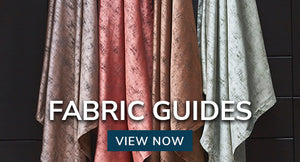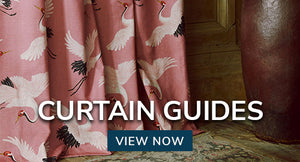Everything you'll ever need to know about roman blinds
They are among the most popular window treatments as they offer elegant styling and compliment any style of home and decorating motif beautifully; but exactly what are roman blinds? Available in a wide range of fabrics, colours and patterns Roman blinds offer an affordable way to give a room pizazz and style. Let's take a look at Roman blinds in more depth.
Need Help Making A Roman Blind?
We have recently published a great guide on how to make a roman blind. All you need to do is answer a few simple questions and you will find the exact advice for your needs:
What are Roman Blinds?
Roman blinds have been used as an effective window covering for centuries, in fact since the necessity for a practical and visually pleasing covering for windows, or window openings, has been needed. Flat pieces of fabric when used centuries ago to cover wall openings, which in later centuries had glass installed and became known as windows, to help prevent dust entering homes and to keep prying eyes from seeing inside a room. As the centuries past vertical operating cords were added to enable the blind to be raised or lowered when required.

How are Roman Blinds Constructed?
Made from a piece of flat fabric a Roman blind has a lining or blackout lining attached to the back of the fabric to form a sealed pocket, similar to an envelope, which has pull cords attached for raising and lowering the envelope of fabrics. When raised the fabric automatically folds and stacks on top of itself, creating a series of neat horizontal folds. When closed, lowered, the fabric becomes flat again to entirely cover the window. The folds, or pleats, are made by the insertion of slim wooden, metal or plastic rods, known as dowels, that fit into channels, or they can be made by tapes which are stitched horizontally across the back of the fabric at equidistant intervals.

A series of cords are equally spaced across the width of the Roman blind and then threaded vertically down the length of the blind passing through the channels or tapes and securely attached to the bottom channel or tape. Once the blind has been threaded it is fixed to a metal or wooden header rail. The blind cord tops are threaded through hooks or cord carriers in the header rail and taken to either the right or left side of the blind where they all meet and create leverage in a the same way as a pulley system.
How Do You Operate a Roman Blind?
When the cords are all pulled together simultaneously the bottom dowel is raised up to meet the dowel above it. This creates a fold in the fabric, the higher the blind is raised the more folds are created until it is fully opened. The number of folds created is determined by the length of the window. The rods, channels and cords are all discreetly placed at the back of the blind and never visible from the front. This simple, yet effective, construction technique is what makes it possible to make Roman blinds from a wide variety of fabric textures and weights.

Which Rooms can Roman Blinds be Used in?
Due to the range of choice of fabrics and colours available for Roman blinds they can be used in virtually any room in your home. Roman blinds are masters at providing a sophisticated, elegant window dressing and are most often seen adorning windows of living rooms, dining rooms, master bedrooms, guest rooms, children’s room, conservatories and offices as they offer a more furnished look than roller, Venetian and vertical blinds. In conservatories and south facing windows that are subject to harsh sunlight, it is best to choose pale colours to help reduce the visible signs of fading over years of being in place.
Insulating and blackout linings can help reduce fading, however, after years of consistently facing the sun fading is bound to occur to some degree. In bedrooms blackout linings are advisable, as these will help to keep the bedroom free from unwanted light pollution, making the room more conducive to rest and sleep.
Is it Possible to Use Roman Blinds in Kitchens and Bathrooms?
As Roman blinds aren't usually made with moisture resistant fabrics or wipe-clean fabrics that are often used for humid atmospheres found in kitchens and bathrooms. However, with careful fabric selection, and the correct maintenance, there is no reason why you can't use a Roman blind in your kitchen or bathroom. It is advisable to avoid completely plain fabrics as they are more likely to show splash marks, especially on luxury fabrics such as velvet, taffetas and faux silks.
Polyester/cotton blends and 100% cotton is a better choice for humid atmospheres as they are more durable and far easier to maintain. When using a Roman blind in a room which is subjected to humidity it is advisable to mount it so that the fabric isn't touching the glass or tiled walls which are prone to hold condensation and moisture. Fixing the blind slightly forward in the window recess, rather than at the back, will help to alleviate the problem.

When ordering made to measure Roman blinds you simply have to choose the fabric and lining type, provide the measurements and say which side you'd like the controls to be on and they will be custom made to your requirements. You don't need to make any hem and seam allowances, nor do you need to allow for clearances if you are going to fit the blind inside the window recess. There is also no need to assemble the blind, as the cords come ready threaded, adjusted and with a safety retainer.
As all of the Roman blinds from Terrys Fabrics come ready to install, they will be attached to the cassette header or track. When you receive your Roman blinds all you have to do is follow the fitting instructions for the brackets and then click the pre-assembled blind into place. For detailed fitting instructions take a look at our guide to installing a Roman blind. For further information on safety precautions with cords and chains on Roman blinds please take a look at our Blind Safety guide.
Can Roman Blinds be Made From Any Type of Fabric?
Roman blinds can be made from a wide choice of good quality fabrics. Plain, semi-plain or patterned fabrics can be used to coordinate or contrast with the colour scheme of your room. Pictorial and patterned fabrics can also be used to add visual interest to a window and compliment a room's theme, while plain blocks of colour can be used to add a splash of colour. It is also possible to use the same fabric as other soft furnishings in the room to create a totally coordinated and matched style.
Best Fabric Choices
As Roman blinds can be made from various weights and thickness of fabric they can be used to create different looks. Lightweight taffeta or faux silk is ideal for creating crisp looking folds which shows off the smooth, lustrous sheen of the fabric beautifully. Medium weight cottons, polyester/cotton blends, linen, blended linen, damasks and Jacquard fabrics are ideal for making Roman blinds. All of these fabric choices are available in an extensive range of colours and patterns which not only looking stunning, will provide a durable Roman blind with longevity. Any non-stretch fabric will create crisp, sharp folds that remain straight and true, giving the blind a professional finish.

Heavy weight fabrics such as velvet, crushed velvet, chenille and pure wool fabrics can also be used for Roman blinds, as they are able to be raised to create soft, neat folds and pleats. However, these fabrics do not make sharp, crisp folds or lay as flat as medium weight cottons, but they will give a sumptuous, voluptuous look that will not have any detrimental effects on the operating mechanisms. Heavy weight fabrics are a good choice for ill-fitting and draughty windows as they'll provide a layer of insulation to the windows.
Limitations With Curtain Fabrics
As the vast majority of curtain fabrics come with a 138cms (54'') width there may be some limitations on using them. It stands to reason that if your window's width exceeds 138cm the fabric isn't going to be wide enough to make a Roman blind. Made-to-measure Roman blinds are available up to a maximum width of 300cms (118''). As this width requires more than one width of curtain fabric it will have neat joins, with the pattern matched where necessary, to achieve your required width.
The centre of the blind will have a full panel with the joined fabric equally placed either side. Seams are never placed down the centre of the blind as this would look unprofessional and far less stylish. Custom made Roman blinds are ideal for large picture windows as they provide a view to the outside world and provide a stylish window treatment.
Fabrics to Avoid
Although it is hard to choose a wrong fabric for made to measure Roman blinds there are some that should be avoided.
Upholstery Fabrics
Most upholstery fabrics, more especially heavyweight fabrics, should be avoided for Roman blinds. Upholstery fabrics are typically thick to give them durability and strength, but they are also treated with fire retardant chemicals by dipping the material or back-coating it. This makes the material very stiff which prevent the Roman blind from folding correctly.
Pure Silk
Pure silk is not recommend for Roman blinds as it is affected by both moisture and harsh sunlight. Moisture can cause delicate silk to rot and harsh sunlight fades and deteriorates the fabric quickly. Neither of which scenarios is conducive to creating a practical and durable window dressing.
Stretch Knit Fabrics
All fabrics that are knitted or have a stretch weave are unsuitable for making Roman blinds. The fabric panel, or panels, for making Roman blinds needs to be cut with true, straight edges, which isn't possible if the fabric cannot be measured and cut precisely. Stretch and knit fabrics also have a tendency to go out of shape easily, making the blind look unsightly and difficult to operate.
PVC, Vinyl and Oil cloth Fabrics
Any fabric which as a waterproof or gloss coating, such as PVC, vinyl and oil cloth, should never be used to make Roman blinds as they are too stiff to fold into pleats when raised. There surface also creates too much friction and resistance, giving the fabric a sticky effect that will prevent the blind from working properly. This excess friction will put undue stress on the blind itself, the track and the operating system.
Faux Leather Fabrics
Fabrics referred to as leatherette are not suitable for Roman blinds for the same reasons as PVC, vinyl and oil cloth. They are too heavy and thick to create folds and despite the nature of the fabric they can easily tear and rip. Faux suede on the other hand would be a suitable choice as it is more pliable and softer with less resistance.
Sheers and Voiles
Due to the transparent nature of sheers and voiles these fabrics are not recommend for Roman blinds. Although the lightweight nature of the fabric means it will fold and drape beautifully Roman blinds need to be lined and placing an opaque fabric lining behind a transparent or semi-transparent defeats the object of choosing sheers. If the blind were to be made unlined the tapes channels, dowels and cord would be visible through the sheers or voiles when the blind is lowered and this is not a visually pleasing look.
Linings for Roman Blinds
Good quality lining fabric needs to be used in order for a Roman blind to be made correctly. The lining not only hides the tape channels, dowels etc., it also gives the blind fabric stability and shape, enabling the skilled seamstresses to achieve accurate finished measurements. The lining also protects the face fabric from fading due to sunlight and helps prevent the face fabric from touching any moisture present at the window.
Tapes and Cords
The lining is used to host the stitch channels or tapes that hold the dowels and operating cords. As both the lining and the tapes are usually white or cream they become virtually invisible when looking at the blind from from the outside of the window in the lowered position. This gives the blind a smart, professional finish from both sides.
Why not to Choose Coloured Lining?
There are two main reasons for not choosing a coloured lining: (1). The sun can create a faded, striped effect on the back of the blinds. (2). White or cream tapes or stitch channels do not look attractive against dark or bright coloured fabrics when the blind is viewed from outside the window.
Dim-out and Shading Linings
The lining plays an important role in the type of shading the blind creates for your window. Polyester/cotton or standard cotton give what is known as 'standard' shading to a Roman blind. It will help protect the back of the face fabric from being damaged by the sun, but will not prevent light from filtering through the face fabric. The standard lining is useful if you want to lower the Roman blind during the daytime to prevent sun glare without completely darkening the room.
Blackout Linings
Blackout or blockout linings do exactly as the name implies. They block out unwanted outside artificial or natural light from passing through the face fabric. Blackout linings are recommend for all bedroom Roman blinds and rooms which require good levels of sun blocking such as media rooms and home theatres. Blackout lining is also recommend on very lightweight fabrics such as lightweight cotton, faux silk and taffetas. These fabrics have a semi-transparent nature, particularly when daylight or bright sun are behind them, which means the dowel tapes, seams and operating cords may be visible when the Roman blind is lowered. This is not a very visually pleasing effect and the blackout lining will help prevent this for happening.

These lightweight fabrics are also subject to slubs, naturally occurring small lumps of tread trapped in the weave, which can look like slightly darker patches or plucks which can create tiny holes in the weave of the fabric through which strong daylight make visible. A blackout lining prevents either of these two issues from being barely noticeable. Today's modern blackout linings aren't bulky and thick, so don't think that they will detract from the beauty of a lightweight face fabric. Quite the contrast in fact, they will give stability and sustenance to the overall look. Wide Roman blinds which have been made from more than one piece of fabric will also benefit from a blackout lining as the seams may be visible through the face fabric if only a 'standard' lining is used. As a blackout lining prevents light from penetrating through the blind it eliminates any shadow lines from the seams.
Recommended Linings
We offer a choice of three quality linings suitable for Roman blinds. 1. Standard – Polyester/cotton, available in cream only. 2. Luxury cotton sheen – Cotton, available in white or cream. 3. Supersoft blackout – Cotton, available in white or ivory. Simply make your selection from the drop menu as you go through the ordering system.
Difference Between Blind Tracks and Curtain Tracks
Roman blinds have provided stylish window treatments for centuries. Today they continue to be one of the most popular window dressing choices and while their operating principles are basically the same, modern technology and manufacturing techniques, along with increased awareness in Health and Safety, have enabled Roman blinds to evolve to meet modern demands with the introduction of metal tracks, known as header rails, to replace the wooden baton, along with the introduction of a child safety mechanism. Curtain tracks on the other hand have a different construction and operating system and are unsuitable for mounting Roman blinds on.
'Standard' Tracks
Aluminium Roman blind track systems, referred to as 'standard tracks', have been available for many years. They have the ability to handle light, medium and heavy weight fabric for small and medium sized windows effortlessly. The track system consist of a flat aluminium track with a Velcro front. Plastic cord carrier loops channel the cords correctly into place and are suspended beneath the track. A locking mechanism is supplied for one end of the track. The locking mechanism operates by trapping the cord between a pulley wheel system making the blind easy to use. The locking mechanism can be fixed at any height between the fully raised or lowered positions without the need to warp excess cords around the cleat hook. For health and safety reasons cleat hooks are still recommended, so that not excessive amounts of cords aren't loosely hanging.
What are Cassette Header & Deluxe Sidewinder Header Rails?
Further advancements and improvements are continually being made and today improved versions, referred to as Cassette Header Rails or Deluxe Sidewinder Headrails are common place. These enclosed, discreet and ingenious header rails consist of a hollow 'U' shaped metal tube, (track) which houses a series of cassette disks or pulleys. It has a central steel bar through both the centre of the track (tube) and the centre of the pulley. Each cassette has a pre-determined length of robust cord wound round it and the sidewinder pulley is at one end of the cassette track.
A continuous bead chain mechanism turns the centre bar, thus turning the cassettes and winding or unwinding cords, depending on which way the chain is pulled, which raises or lowers the custom made Roman blind. Unlike the 'standard' Roman blind track system which works by having to pull on the cords grouped together at one end, the sidewinder chain operates the blind by winding the cords up and down. This not only provides a better and more reliable operating system but also improves health and safety. Cassette, sidewinder, header rails are supplied with a safety hook or clip which anchors the beaded chain at the end of the header rail securely to the wall under slight tension. This reduces the risk of accidental strangulation.
Cassette Header Rails have 3 main advantages over 'standard' header rails.
1. The cords in cassette header rails last longer than those in 'standard' header rails as each individual cassette pulley puts less stress on them. This makes cassette header rails well suited for very long or wide windows.
2. Their construction gives the ability to cope with any fabric weight.
3. All the cords are housed within the header rail when the blind is fully raised so there are no excess cords to be wrapped around a cleat hook. The appearance of cassette header rails looks bulkier in compassion to a 'stand' header rails, however, it is hidden from view once installed in the window. Despite their appearance cassette header rails are relatively lightweight and yet strong, durable and reliable. Some of the made-to-measure Roman blinds available will offer the 'standard' blind track as an option, however, ALL of our Roman blinds are available with a Deluxe Sidewinder Header Rail option.
Do I have to Supply my Own Track if I Order Made to Measure Roman Blinds?
The simple answer is 'no'. When purchasing made to measure Roman blinds from the track is supplied.
Advice on Submitting Measurements for Custom Blinds
There is nothing nicer than having bespoke, custom made blinds in your home. Knowing that you have chosen the specific size, fabric texture, colour and design to compliment your decorating style and colour scheme makes made to measure Roman blinds unique. Don't be put-off or deterred from ordering them because they sound too complicated.
With a simple step-by-step ordering system, with drop down boxes and check-lists to help and guide you, the ordering process is easy. The system also has an instant price calculator, so you won't be in for any unexpected additional costs before committing or parting with any money. Should you still have any doubts about your measuring skills take a look at our guide on How to measure for Roman Blinds.
Choices in Fitting Roman Blinds Inside or Outside of the Window Recess
Once you have decided to use Roman blinds as your window dressing the next step is to decide whether you want them installed inside or outside the recess of your window. This decision is your choice, however, here are some points worth taking into consideration.
Small Windows and Windows With Low Level Light Sources
Rooms with small windows and a poor natural light source need a window dressing that maximises what little light you have to make the room look and feel lighter and more spacious. If wall space or other obstructions aren't an issue Roman blinds fitted to the outside and above of the recess can help you achieve more light and the illusion of larger windows.
Mounting the blind above the window recess to accommodate the stack depth, the measurement of the Roman blind top to bottom when it is raised, means that it won't sit next to the window pane and therefore not obstruct the light source as much as it will if the blind was installed inside the recess.
Architectural Window Details
When your window has architectural details, such as picture or dado rails that are inside the recess, you have to decide what width the Roman blind should be if you want to fit it inside the recess. If you decide to take the blind measurement between the width of the decorative feature there will be a gap both sides of the blind when it is fitted; alternatively you can fit the blind across the full width of the recess and accept that the blind may look slightly uncomfortable when it knocks against the mouldings. In this scenario it is worth considering fitting the Roman blind outside and above the recess to eliminate the issues.
Only Blinds or Curtains as Well?
When dressing windows in certain styles, such as 'swags and tails' there is a working blind fitted into the recess and curtains, swept open from the centre and draped down the sides to form the 'swags and tails, which stay in place, and are never drawn closed. In this scenario you will be unable to mount the blinds outside the window recess as this is where the curtain track will be.
When Roman blinds are the only window dressing it is often a better option to fit them to the outside of the window recess. This style gives a classy, elegant look to the window, particularly in living rooms, dining rooms and bedrooms, as the bottom edge of the blind typically covers the top edge of the window recess, adding a subtle softness to the window and taking the bareness off the room.
Limited Wall Space
When you little or no flat wall space at either side of the window then it is worth considering fitting the Roman blind inside the recess. Ideally Roman blinds should be fitted to the outside of the recess, extending a bare minimum of 5cms (2 ½ '') both sides of the window. Usually 7 – 10cms (3'' – 4'') is the recommended amount of extension beyond the window frame required for the blind to look stylish, and to help prevent light from creeping around the sides. if you don't have the bare minimum of 5cms the blind would probably look better fitted inside the window recess.
Can You Successfully Use Roman Blinds in Bay Windows?
Bay windows are notorious for being difficult to dress with any type of window dressing, however, by giving consideration to the options, some careful planning and using hints and tips from 'the experts', you can dress your bay windows stylishly with Roman blinds. Always give consideration to the corners and angles of your bay window, take time to get the measurements correct and follow the guide below to dress your bay window in elegant style.
Measuring for Bay Window Roman Blinds
There are generally three types or styles of bay windows – curved, boxed and splayed (angled). Each has its own specific guidelines of how they should be measured and fitted. Below are a few things to keep in mind.
Bay Window Types
Boxed
Boxed bay windows have three sides, with a wider central panel with much narrower panels each side. The two side windows are at a 90 degree angle to the main, central panel, which creates a boxed, or oblong shape window. Boxed bay windows are considered to be the hardest type to dress with any type of blinds, including Roman blinds, due to the 90 degree angles presenting not only measuring challenges but also require consideration on how and where the blinds should meet. As Roman blinds stack on top of each other when they are raised (open) they create a certain amount of volume or bulk at the top of the window. Accurate measuring is required otherwise there is a risk that the blinds will overlap which means that raising and lowering them can cause problems.
Curved
Curved bay windows have five or more sides which are joined at much shallower angles to create the curve. Planning and measuring involves measuring for an inside recess fit and calculating the finished blind size rather than supplying the recess size measurements. Again the measurements need to be correct to help avoid the blinds interfering with each other when being raised or lowered. The volume created at the top of the window also needs to be taken into consideration.
Splayed or Angled
Splayed or angled bay windows have three sides. The central panel is wider than the two side panels like a boxed bay, however, the two side angles on splayed bay windows are 45 degrees which creates the angled style without it looking like a box. Just like boxed and curved bay windows careful measurements are required to help prevent overlapping when the blinds are being operated. Also the volume created at the top of the window when the blinds are raised needs to be considered.
Considerations for the 3 Types of Bay Windows
Before you take the measurements for your Roman blinds you need to consider whether you want the inner side edges of the side blinds to the touch the side edges of the main centre panel (panels for a curved bay window) or whether you would prefer to have a slight, but obvious, gap between them. Both ways are acceptable, it is just a matter of personal preference, however, you should also consider the following:- Roman blinds which touch at the side edges look very neat and tidy and are better at blocking out the light, however, they can create a stacking issue when the blinds are raised (open) in the fully stacked position due to the volume of the fabric.
- Crushing issues can also be a problem in this scenario, as the stacks of folds on the centre panel will meet the stacks of folds on the side panels at the angled corners of the bay window. By choosing to have a slight gap between the side of the blinds can help alleviate the potential crushing issue.
- Alternatively you may like to consider having each blind raised, open, at a slightly different level to avoid the problem. This is created by having the central blind raised fully to the top of the window and having the side panels raised to sit just below the stack folds of the central blind. This method gives a symmetrical and balanced look to the window dressing which gives very acceptable modern styling.
- With either option the blind needs to be set forward in the recess so that the back of the blind doesn't snag on the window's handles or catches and stop it from being raised or lowered easily. Not only will the blinds look unsightly if the handles make bulges, there is also the risk of the fabric being damaged and ripped or the operating cords becoming snagged.
- If you want the side blinds to touch the sides of the central blind/s you need to take the measurements from the corner point to where you want the outer edge of the blind to finish.
- If you want the blinds to have slight gaps to alleviate the potential crushing issue, then you need to take off the allowance to suit the look you're after. However, you need to ensure that each blind measurement has the same amount take off to obtain a balanced and even look. Also take into consideration that the more allowance you take off the more the chances are that you will see the glass window pane, which does not give a smart, professional look and of course, will allow light to be seen around the sides and not give total privacy.
- Consideration of the depth size, front to back, is required because this will determine the type of header rail the Roman blind is going to be fitted on. The front point of the header rail is where the fabric of the blind is fixed to and therefore the point at which you need to take the measurements from. For example, if the thickness of the header rail is 40mm (1 ½ '') from front to back, then, even if it is flush against the window frame and it doesn't need to be moved forward to clear handles and catches, then you need to take the blinds' measurements 40mm (1 ½'') forward of the window frame.
- If you need to fix the blind forward to clear the handles and catches, for example another 10mm (½'') then the front of the Roman blind will need to be a total of 50mm (2 ½'') forward of the frame – 40mm + 10mm = 50mm. This will be the position from which you need to take your width measurements.
Tips to Using Templates
To make measuring easier, to take away any guess work and to obtain accurate measurements a paper or cardboard template is recommended.
Making the Templates
Measure each section of the bay accurately. Transfer these measurements to the paper or cardboard using a straight edge and cut the template form. You should have one template for each part of the bay. For example, for boxed and splayed bay windows you should have three templates, for curved bay windows five, or more. Write on each template which section it is. e.g. centre, side left, side right.
Left Side
Place the centre panel template onto the ceiling of the bay, flush against the window frame, place the left side template onto the ceiling of that section and slide them towards the corner angle until they meet and crossover slightly. The point where the two front edges cross is the place where the blinds will meet if you choose to have them without a gap between them. Place a small pencil mark at the corner point or, if possible, draw a faint pencil line along the front edge of the template to trace the outline of the corner.
Right Side
Repeat the same procedure at the top right hand corner of the window. If you choose to have a gap between the blinds, so that they aren't touching reduce the measurements slightly either side of the blinds to achieve your preferred look. Note: Don't try and make the allowance too big or you will be able to see the line where the window frame meets the edge of the glass, and this is not a desirable look.
Professional Tips:
- The inside recess measurements you provide for made-to-measure Roman blinds need to be very accurate.
- Always use a good quality steel tape measure rather than a fabric one, as fabric tape measures can stretch and give inaccurate measurements.
- Measure twice and order once! Take time when measuring, and always double check to ensure they are right.
- Ask someone to help you take the measurements, when possible, to ensure accuracy.
Choose with Confidence
With over 40 years experience in providing quality made to measure blinds, we can offer an extensive range of fabrics suitable for making beautiful Roman blinds, which means you can make your selections with confidence. Our easy to find search options you are able to choose by fabric or pattern type and colour. We have a simple check-list ordering process, so it couldn’t be easier to find exactly the style of Roman blind you're looking for.



























































